Holmes Institute HI6006 Competitive Strategy Essay: Strategy Tools
VerifiedAdded on 2022/09/26
|10
|1779
|32
Essay
AI Summary
This essay, prepared for Holmes Institute's HI6006 Competitive Strategy course, provides a comprehensive discussion of three essential strategy development tools. It begins with an overview of the Porter's Five Forces model, detailing its application in analyzing the microenvironment and competitive forces faced by businesses, using Woolworths as an example. The essay then explores SWOT analysis, emphasizing its role in assessing internal strengths and weaknesses alongside external opportunities and threats, with a case study of ANZ Bank. Finally, the PESTEL analysis model is examined, focusing on its utility in evaluating the macro-environment and its impact on strategic decisions, with Wesfarmers as a practical example. The essay concludes by summarizing the importance of these frameworks in developing effective organizational strategies and achieving business goals.
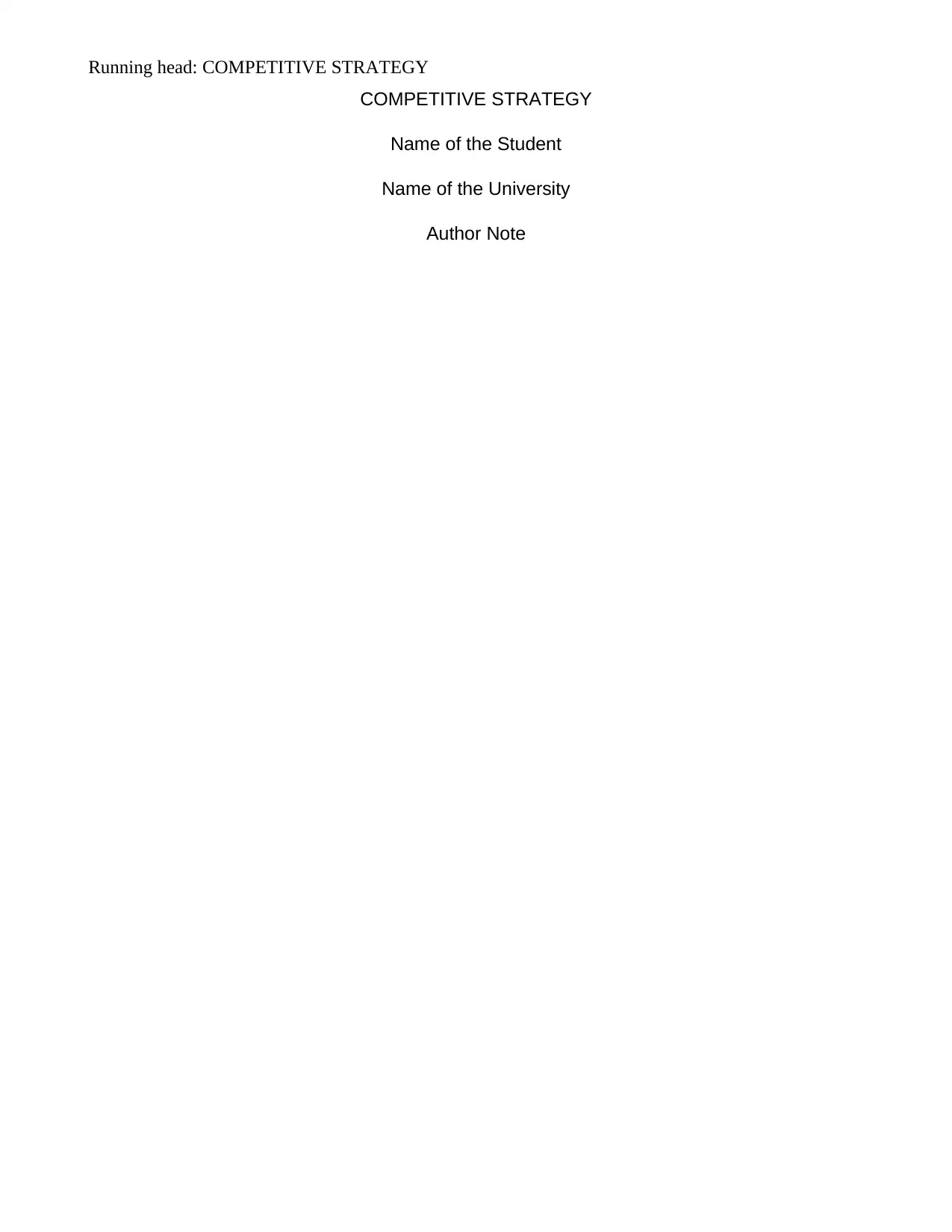
Running head: COMPETITIVE STRATEGY
COMPETITIVE STRATEGY
Name of the Student
Name of the University
Author Note
COMPETITIVE STRATEGY
Name of the Student
Name of the University
Author Note
Paraphrase This Document
Need a fresh take? Get an instant paraphrase of this document with our AI Paraphraser
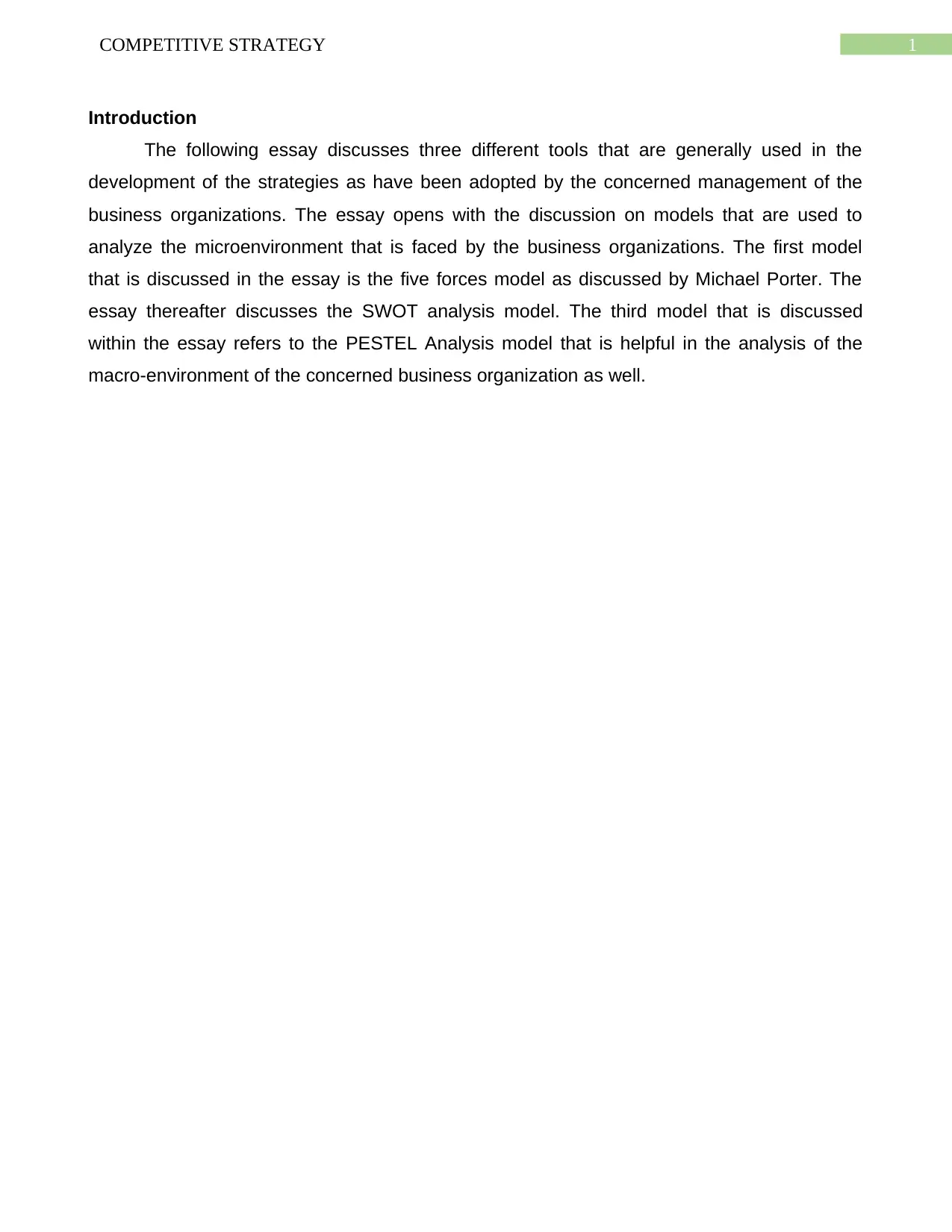
1COMPETITIVE STRATEGY
Introduction
The following essay discusses three different tools that are generally used in the
development of the strategies as have been adopted by the concerned management of the
business organizations. The essay opens with the discussion on models that are used to
analyze the microenvironment that is faced by the business organizations. The first model
that is discussed in the essay is the five forces model as discussed by Michael Porter. The
essay thereafter discusses the SWOT analysis model. The third model that is discussed
within the essay refers to the PESTEL Analysis model that is helpful in the analysis of the
macro-environment of the concerned business organization as well.
Introduction
The following essay discusses three different tools that are generally used in the
development of the strategies as have been adopted by the concerned management of the
business organizations. The essay opens with the discussion on models that are used to
analyze the microenvironment that is faced by the business organizations. The first model
that is discussed in the essay is the five forces model as discussed by Michael Porter. The
essay thereafter discusses the SWOT analysis model. The third model that is discussed
within the essay refers to the PESTEL Analysis model that is helpful in the analysis of the
macro-environment of the concerned business organization as well.
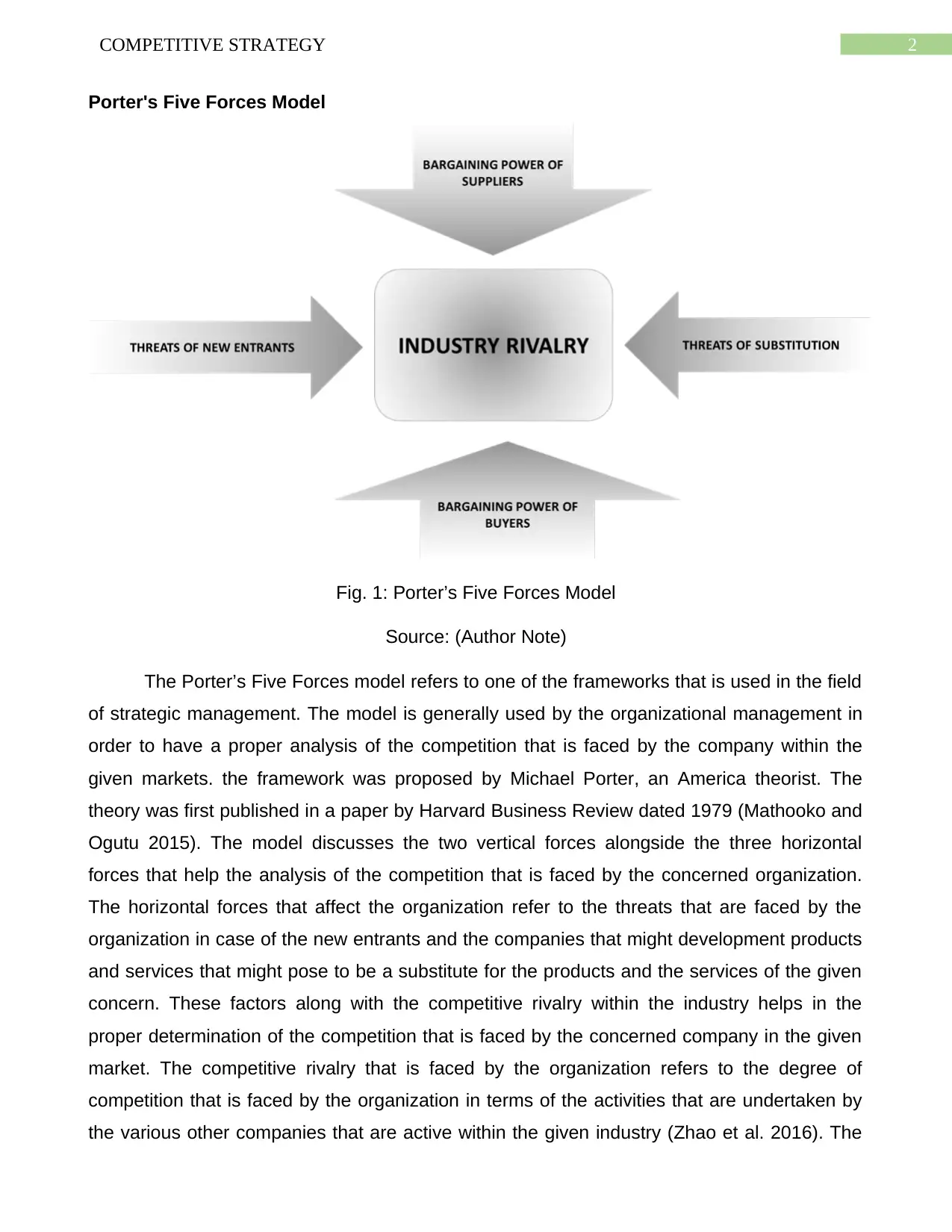
2COMPETITIVE STRATEGY
Porter's Five Forces Model
Fig. 1: Porter’s Five Forces Model
Source: (Author Note)
The Porter’s Five Forces model refers to one of the frameworks that is used in the field
of strategic management. The model is generally used by the organizational management in
order to have a proper analysis of the competition that is faced by the company within the
given markets. the framework was proposed by Michael Porter, an America theorist. The
theory was first published in a paper by Harvard Business Review dated 1979 (Mathooko and
Ogutu 2015). The model discusses the two vertical forces alongside the three horizontal
forces that help the analysis of the competition that is faced by the concerned organization.
The horizontal forces that affect the organization refer to the threats that are faced by the
organization in case of the new entrants and the companies that might development products
and services that might pose to be a substitute for the products and the services of the given
concern. These factors along with the competitive rivalry within the industry helps in the
proper determination of the competition that is faced by the concerned company in the given
market. The competitive rivalry that is faced by the organization refers to the degree of
competition that is faced by the organization in terms of the activities that are undertaken by
the various other companies that are active within the given industry (Zhao et al. 2016). The
Porter's Five Forces Model
Fig. 1: Porter’s Five Forces Model
Source: (Author Note)
The Porter’s Five Forces model refers to one of the frameworks that is used in the field
of strategic management. The model is generally used by the organizational management in
order to have a proper analysis of the competition that is faced by the company within the
given markets. the framework was proposed by Michael Porter, an America theorist. The
theory was first published in a paper by Harvard Business Review dated 1979 (Mathooko and
Ogutu 2015). The model discusses the two vertical forces alongside the three horizontal
forces that help the analysis of the competition that is faced by the concerned organization.
The horizontal forces that affect the organization refer to the threats that are faced by the
organization in case of the new entrants and the companies that might development products
and services that might pose to be a substitute for the products and the services of the given
concern. These factors along with the competitive rivalry within the industry helps in the
proper determination of the competition that is faced by the concerned company in the given
market. The competitive rivalry that is faced by the organization refers to the degree of
competition that is faced by the organization in terms of the activities that are undertaken by
the various other companies that are active within the given industry (Zhao et al. 2016). The
⊘ This is a preview!⊘
Do you want full access?
Subscribe today to unlock all pages.

Trusted by 1+ million students worldwide
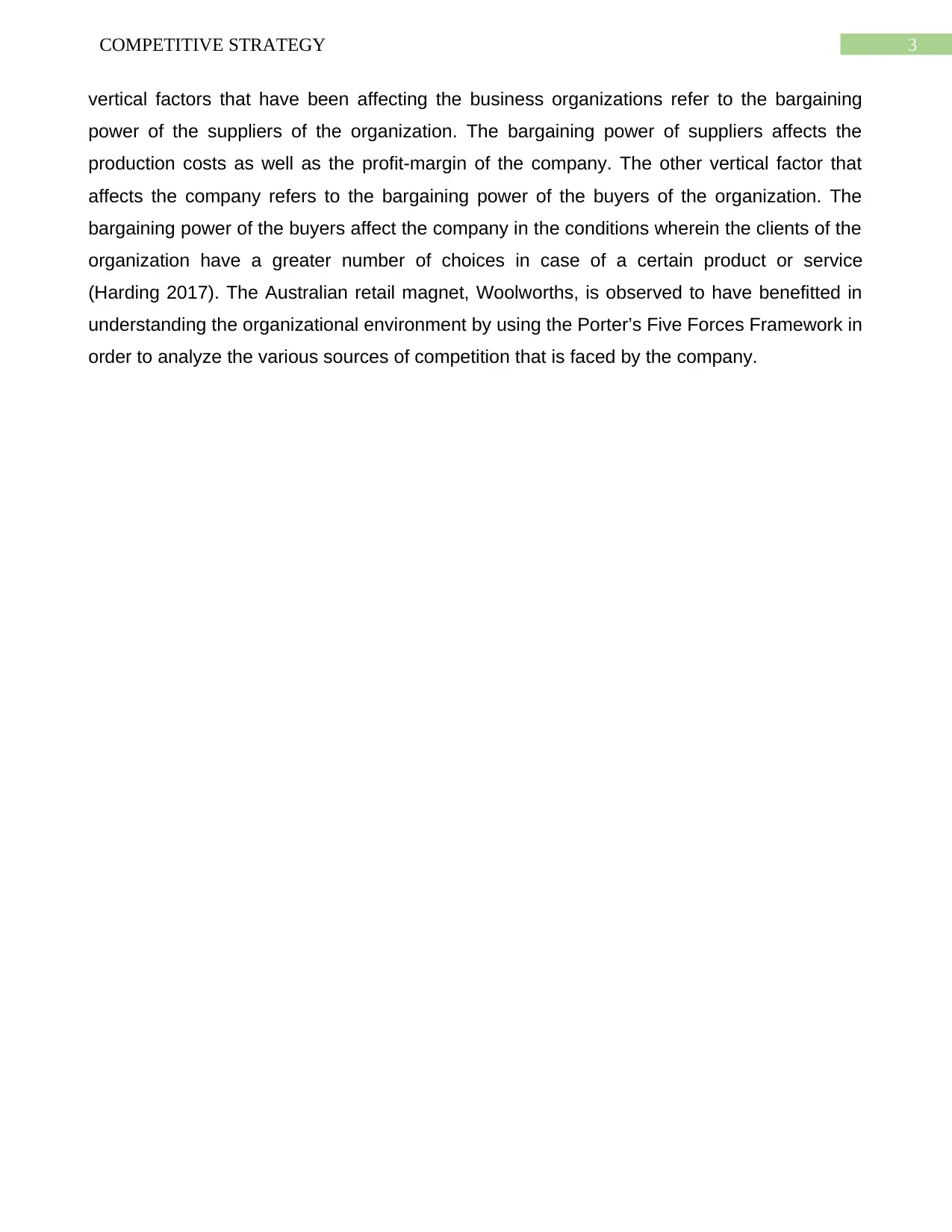
3COMPETITIVE STRATEGY
vertical factors that have been affecting the business organizations refer to the bargaining
power of the suppliers of the organization. The bargaining power of suppliers affects the
production costs as well as the profit-margin of the company. The other vertical factor that
affects the company refers to the bargaining power of the buyers of the organization. The
bargaining power of the buyers affect the company in the conditions wherein the clients of the
organization have a greater number of choices in case of a certain product or service
(Harding 2017). The Australian retail magnet, Woolworths, is observed to have benefitted in
understanding the organizational environment by using the Porter’s Five Forces Framework in
order to analyze the various sources of competition that is faced by the company.
vertical factors that have been affecting the business organizations refer to the bargaining
power of the suppliers of the organization. The bargaining power of suppliers affects the
production costs as well as the profit-margin of the company. The other vertical factor that
affects the company refers to the bargaining power of the buyers of the organization. The
bargaining power of the buyers affect the company in the conditions wherein the clients of the
organization have a greater number of choices in case of a certain product or service
(Harding 2017). The Australian retail magnet, Woolworths, is observed to have benefitted in
understanding the organizational environment by using the Porter’s Five Forces Framework in
order to analyze the various sources of competition that is faced by the company.
Paraphrase This Document
Need a fresh take? Get an instant paraphrase of this document with our AI Paraphraser
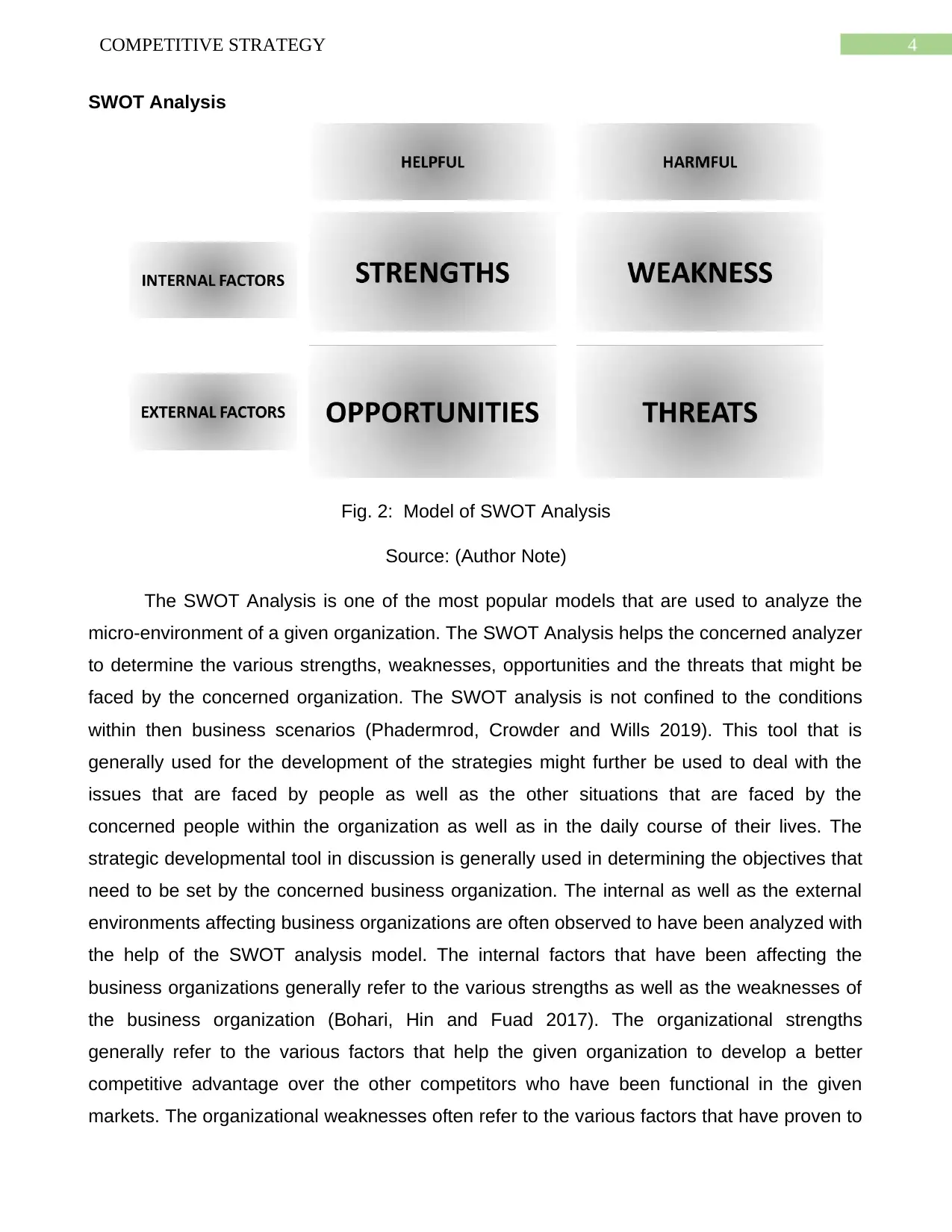
4COMPETITIVE STRATEGY
SWOT Analysis
Fig. 2: Model of SWOT Analysis
Source: (Author Note)
The SWOT Analysis is one of the most popular models that are used to analyze the
micro-environment of a given organization. The SWOT Analysis helps the concerned analyzer
to determine the various strengths, weaknesses, opportunities and the threats that might be
faced by the concerned organization. The SWOT analysis is not confined to the conditions
within then business scenarios (Phadermrod, Crowder and Wills 2019). This tool that is
generally used for the development of the strategies might further be used to deal with the
issues that are faced by people as well as the other situations that are faced by the
concerned people within the organization as well as in the daily course of their lives. The
strategic developmental tool in discussion is generally used in determining the objectives that
need to be set by the concerned business organization. The internal as well as the external
environments affecting business organizations are often observed to have been analyzed with
the help of the SWOT analysis model. The internal factors that have been affecting the
business organizations generally refer to the various strengths as well as the weaknesses of
the business organization (Bohari, Hin and Fuad 2017). The organizational strengths
generally refer to the various factors that help the given organization to develop a better
competitive advantage over the other competitors who have been functional in the given
markets. The organizational weaknesses often refer to the various factors that have proven to
SWOT Analysis
Fig. 2: Model of SWOT Analysis
Source: (Author Note)
The SWOT Analysis is one of the most popular models that are used to analyze the
micro-environment of a given organization. The SWOT Analysis helps the concerned analyzer
to determine the various strengths, weaknesses, opportunities and the threats that might be
faced by the concerned organization. The SWOT analysis is not confined to the conditions
within then business scenarios (Phadermrod, Crowder and Wills 2019). This tool that is
generally used for the development of the strategies might further be used to deal with the
issues that are faced by people as well as the other situations that are faced by the
concerned people within the organization as well as in the daily course of their lives. The
strategic developmental tool in discussion is generally used in determining the objectives that
need to be set by the concerned business organization. The internal as well as the external
environments affecting business organizations are often observed to have been analyzed with
the help of the SWOT analysis model. The internal factors that have been affecting the
business organizations generally refer to the various strengths as well as the weaknesses of
the business organization (Bohari, Hin and Fuad 2017). The organizational strengths
generally refer to the various factors that help the given organization to develop a better
competitive advantage over the other competitors who have been functional in the given
markets. The organizational weaknesses often refer to the various factors that have proven to
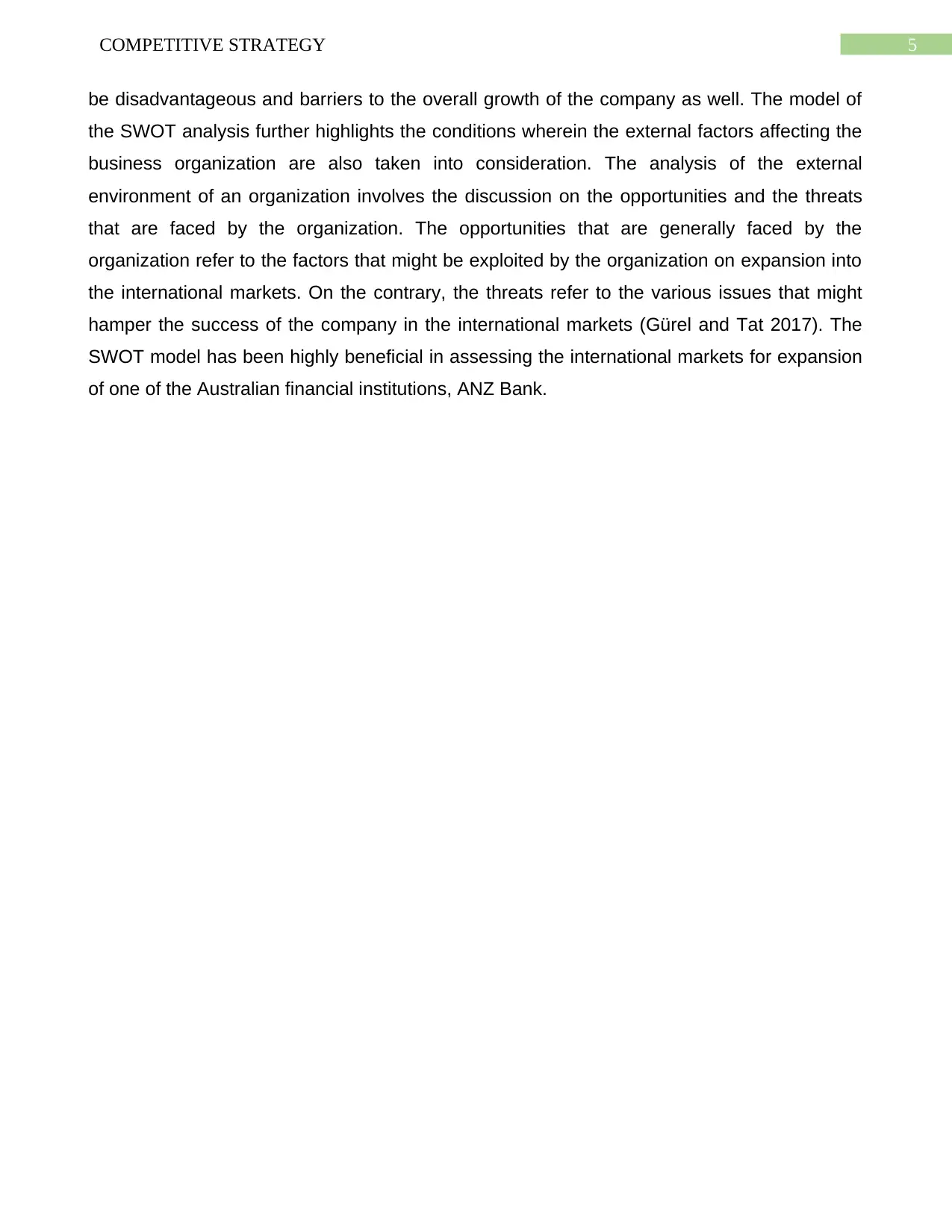
5COMPETITIVE STRATEGY
be disadvantageous and barriers to the overall growth of the company as well. The model of
the SWOT analysis further highlights the conditions wherein the external factors affecting the
business organization are also taken into consideration. The analysis of the external
environment of an organization involves the discussion on the opportunities and the threats
that are faced by the organization. The opportunities that are generally faced by the
organization refer to the factors that might be exploited by the organization on expansion into
the international markets. On the contrary, the threats refer to the various issues that might
hamper the success of the company in the international markets (Gürel and Tat 2017). The
SWOT model has been highly beneficial in assessing the international markets for expansion
of one of the Australian financial institutions, ANZ Bank.
be disadvantageous and barriers to the overall growth of the company as well. The model of
the SWOT analysis further highlights the conditions wherein the external factors affecting the
business organization are also taken into consideration. The analysis of the external
environment of an organization involves the discussion on the opportunities and the threats
that are faced by the organization. The opportunities that are generally faced by the
organization refer to the factors that might be exploited by the organization on expansion into
the international markets. On the contrary, the threats refer to the various issues that might
hamper the success of the company in the international markets (Gürel and Tat 2017). The
SWOT model has been highly beneficial in assessing the international markets for expansion
of one of the Australian financial institutions, ANZ Bank.
⊘ This is a preview!⊘
Do you want full access?
Subscribe today to unlock all pages.

Trusted by 1+ million students worldwide
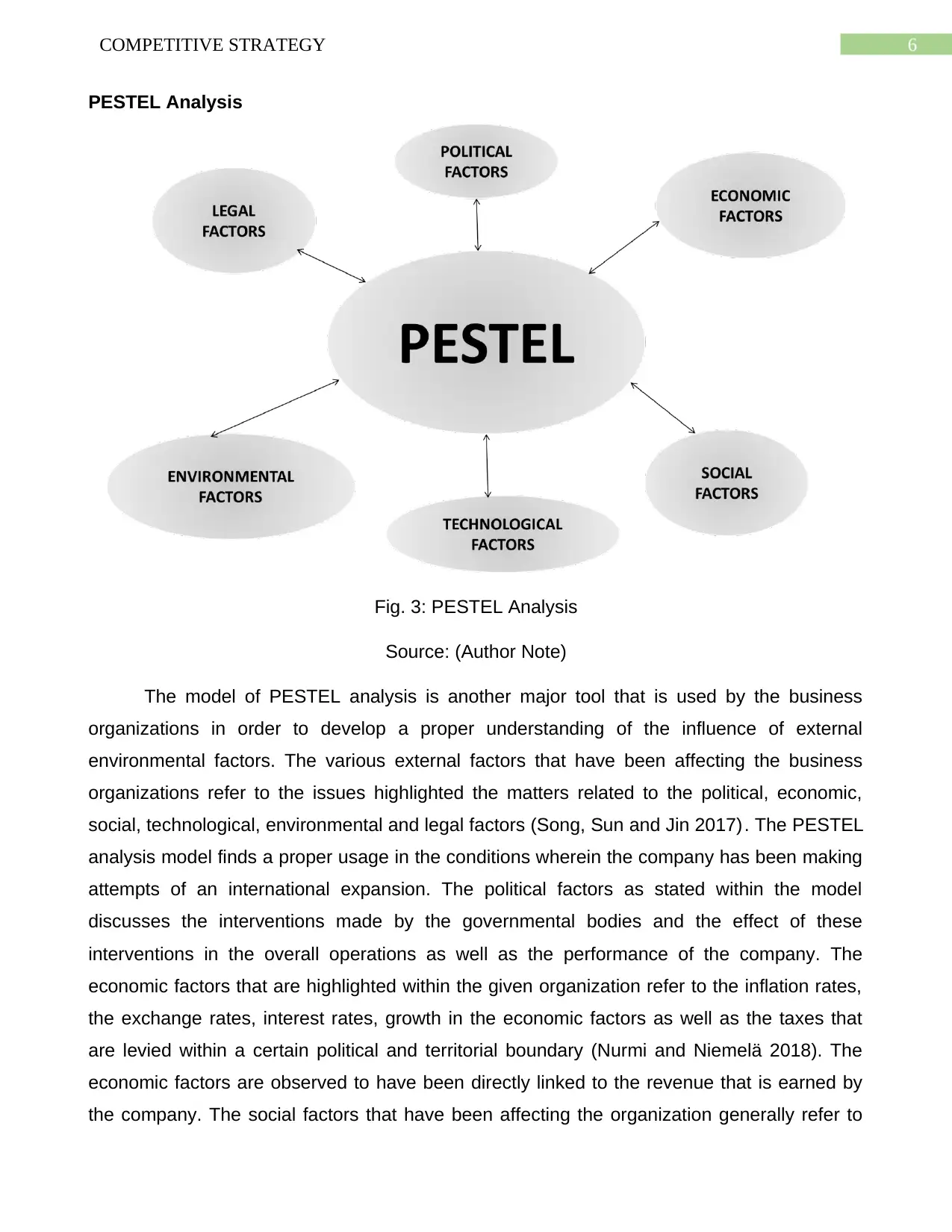
6COMPETITIVE STRATEGY
PESTEL Analysis
Fig. 3: PESTEL Analysis
Source: (Author Note)
The model of PESTEL analysis is another major tool that is used by the business
organizations in order to develop a proper understanding of the influence of external
environmental factors. The various external factors that have been affecting the business
organizations refer to the issues highlighted the matters related to the political, economic,
social, technological, environmental and legal factors (Song, Sun and Jin 2017). The PESTEL
analysis model finds a proper usage in the conditions wherein the company has been making
attempts of an international expansion. The political factors as stated within the model
discusses the interventions made by the governmental bodies and the effect of these
interventions in the overall operations as well as the performance of the company. The
economic factors that are highlighted within the given organization refer to the inflation rates,
the exchange rates, interest rates, growth in the economic factors as well as the taxes that
are levied within a certain political and territorial boundary (Nurmi and Niemelä 2018). The
economic factors are observed to have been directly linked to the revenue that is earned by
the company. The social factors that have been affecting the organization generally refer to
PESTEL Analysis
Fig. 3: PESTEL Analysis
Source: (Author Note)
The model of PESTEL analysis is another major tool that is used by the business
organizations in order to develop a proper understanding of the influence of external
environmental factors. The various external factors that have been affecting the business
organizations refer to the issues highlighted the matters related to the political, economic,
social, technological, environmental and legal factors (Song, Sun and Jin 2017). The PESTEL
analysis model finds a proper usage in the conditions wherein the company has been making
attempts of an international expansion. The political factors as stated within the model
discusses the interventions made by the governmental bodies and the effect of these
interventions in the overall operations as well as the performance of the company. The
economic factors that are highlighted within the given organization refer to the inflation rates,
the exchange rates, interest rates, growth in the economic factors as well as the taxes that
are levied within a certain political and territorial boundary (Nurmi and Niemelä 2018). The
economic factors are observed to have been directly linked to the revenue that is earned by
the company. The social factors that have been affecting the organization generally refer to
Paraphrase This Document
Need a fresh take? Get an instant paraphrase of this document with our AI Paraphraser
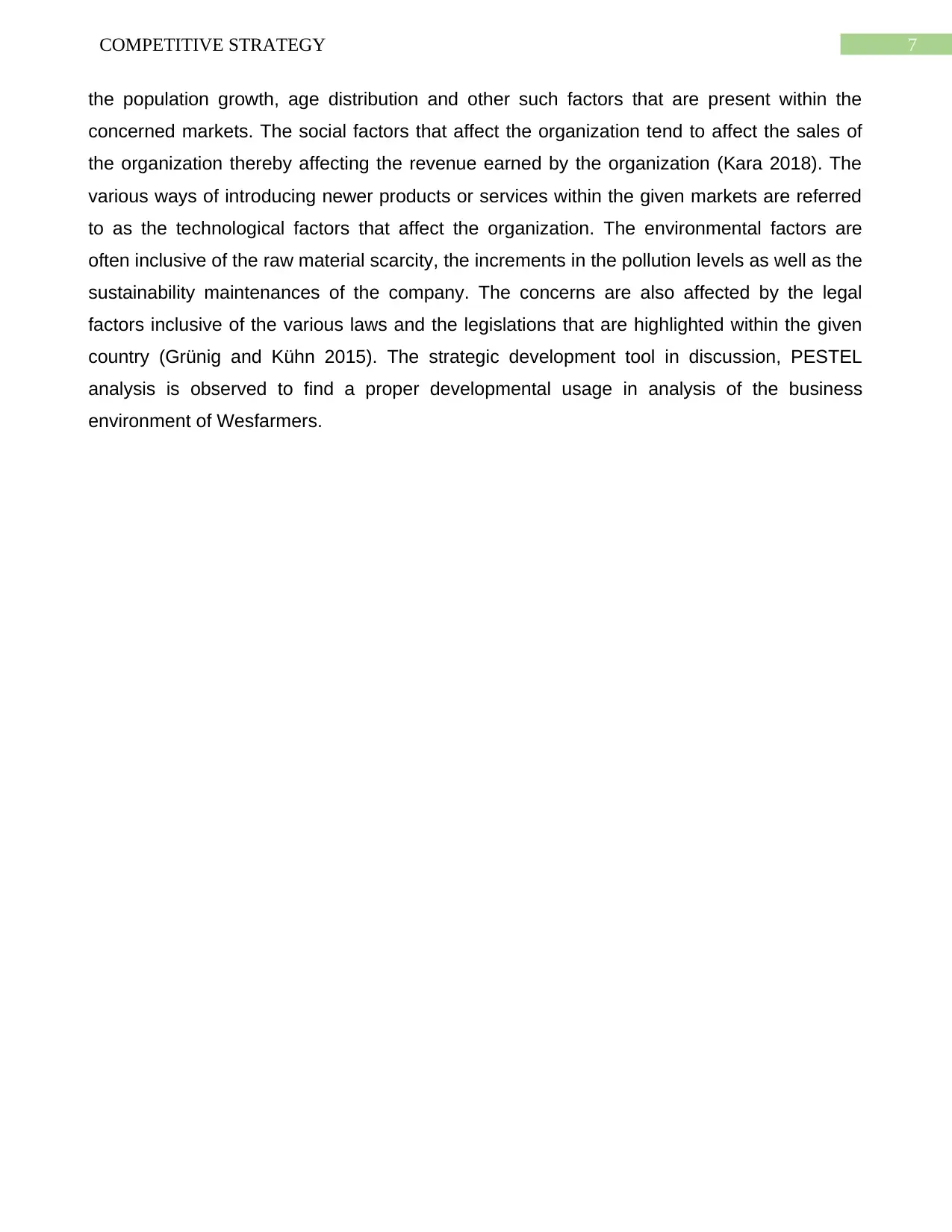
7COMPETITIVE STRATEGY
the population growth, age distribution and other such factors that are present within the
concerned markets. The social factors that affect the organization tend to affect the sales of
the organization thereby affecting the revenue earned by the organization (Kara 2018). The
various ways of introducing newer products or services within the given markets are referred
to as the technological factors that affect the organization. The environmental factors are
often inclusive of the raw material scarcity, the increments in the pollution levels as well as the
sustainability maintenances of the company. The concerns are also affected by the legal
factors inclusive of the various laws and the legislations that are highlighted within the given
country (Grünig and Kühn 2015). The strategic development tool in discussion, PESTEL
analysis is observed to find a proper developmental usage in analysis of the business
environment of Wesfarmers.
the population growth, age distribution and other such factors that are present within the
concerned markets. The social factors that affect the organization tend to affect the sales of
the organization thereby affecting the revenue earned by the organization (Kara 2018). The
various ways of introducing newer products or services within the given markets are referred
to as the technological factors that affect the organization. The environmental factors are
often inclusive of the raw material scarcity, the increments in the pollution levels as well as the
sustainability maintenances of the company. The concerns are also affected by the legal
factors inclusive of the various laws and the legislations that are highlighted within the given
country (Grünig and Kühn 2015). The strategic development tool in discussion, PESTEL
analysis is observed to find a proper developmental usage in analysis of the business
environment of Wesfarmers.
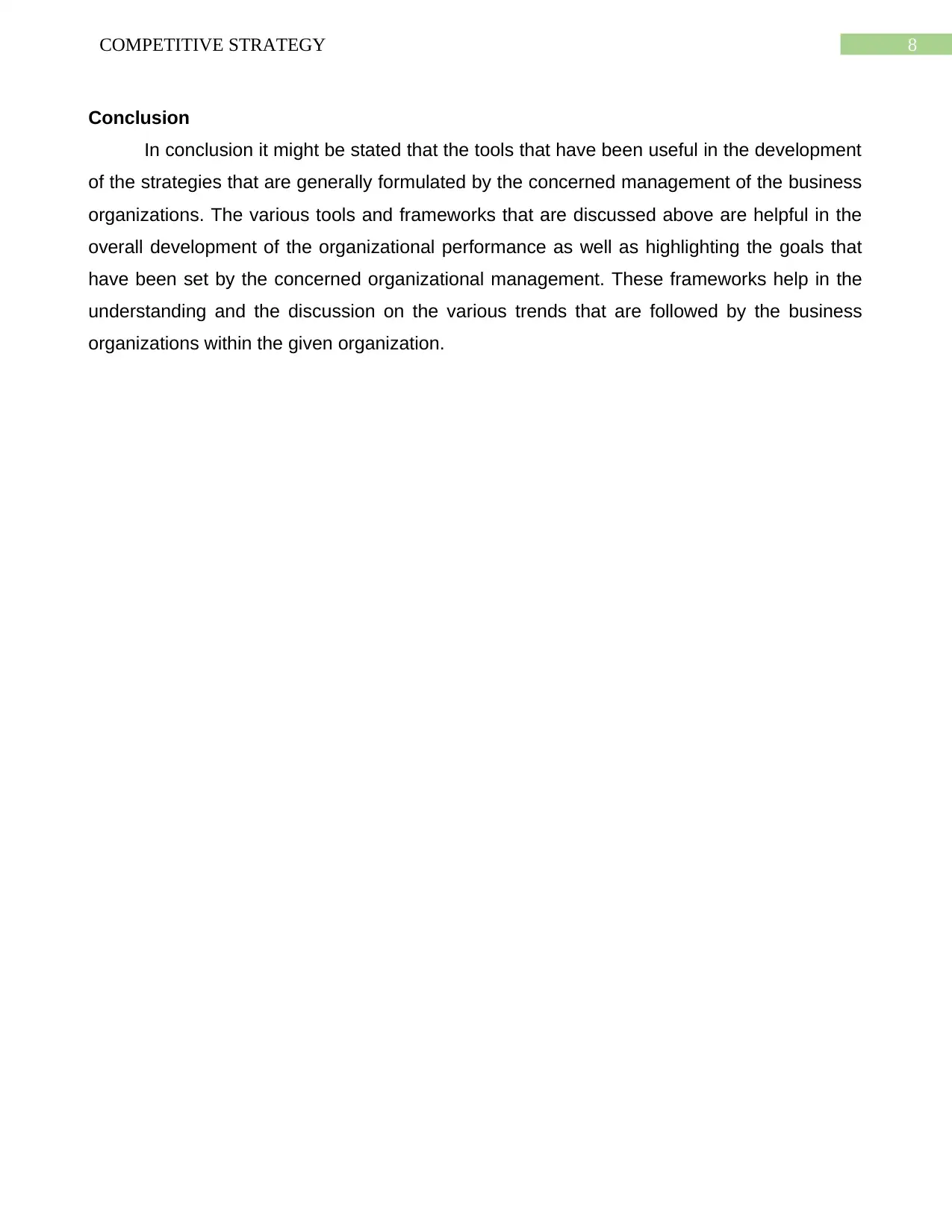
8COMPETITIVE STRATEGY
Conclusion
In conclusion it might be stated that the tools that have been useful in the development
of the strategies that are generally formulated by the concerned management of the business
organizations. The various tools and frameworks that are discussed above are helpful in the
overall development of the organizational performance as well as highlighting the goals that
have been set by the concerned organizational management. These frameworks help in the
understanding and the discussion on the various trends that are followed by the business
organizations within the given organization.
Conclusion
In conclusion it might be stated that the tools that have been useful in the development
of the strategies that are generally formulated by the concerned management of the business
organizations. The various tools and frameworks that are discussed above are helpful in the
overall development of the organizational performance as well as highlighting the goals that
have been set by the concerned organizational management. These frameworks help in the
understanding and the discussion on the various trends that are followed by the business
organizations within the given organization.
⊘ This is a preview!⊘
Do you want full access?
Subscribe today to unlock all pages.

Trusted by 1+ million students worldwide
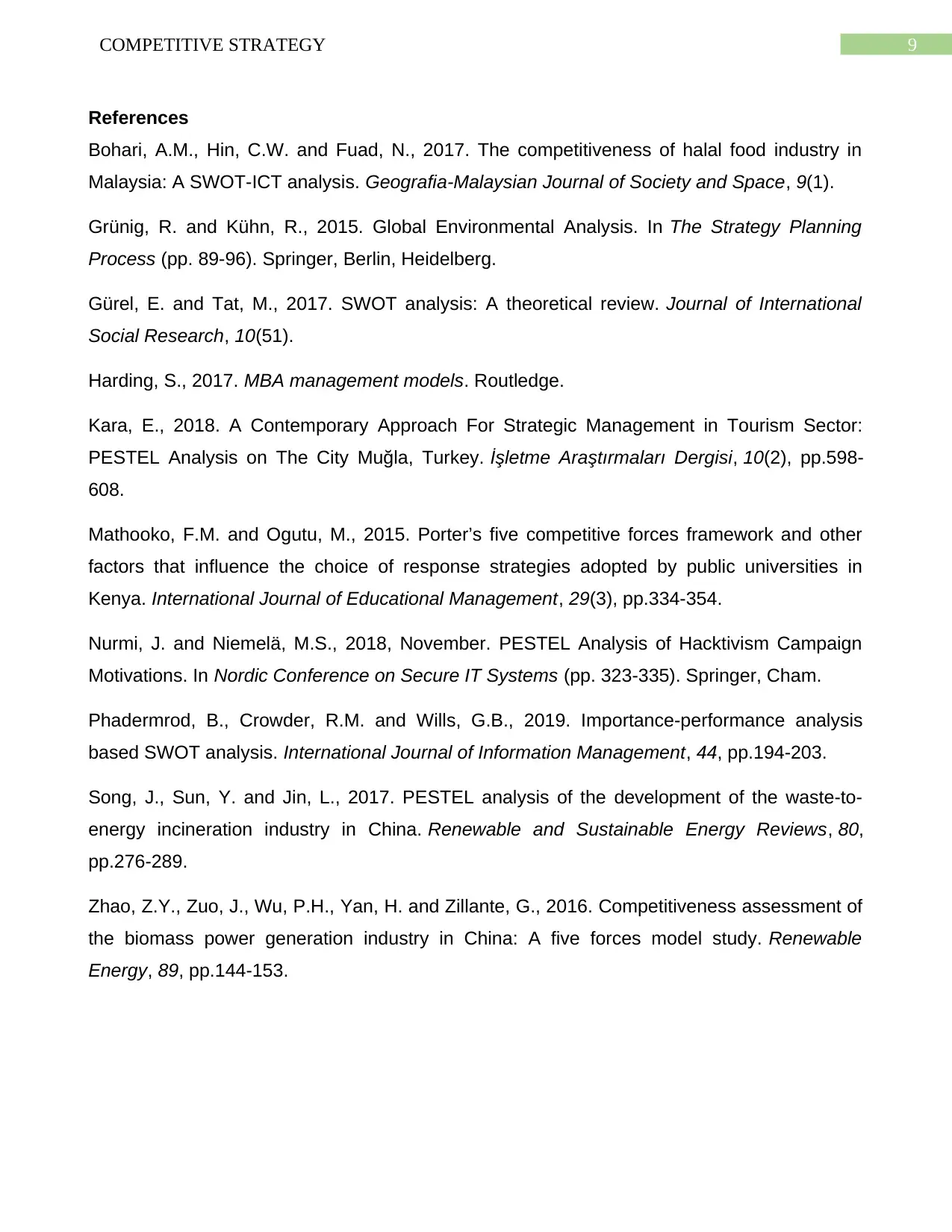
9COMPETITIVE STRATEGY
References
Bohari, A.M., Hin, C.W. and Fuad, N., 2017. The competitiveness of halal food industry in
Malaysia: A SWOT-ICT analysis. Geografia-Malaysian Journal of Society and Space, 9(1).
Grünig, R. and Kühn, R., 2015. Global Environmental Analysis. In The Strategy Planning
Process (pp. 89-96). Springer, Berlin, Heidelberg.
Gürel, E. and Tat, M., 2017. SWOT analysis: A theoretical review. Journal of International
Social Research, 10(51).
Harding, S., 2017. MBA management models. Routledge.
Kara, E., 2018. A Contemporary Approach For Strategic Management in Tourism Sector:
PESTEL Analysis on The City Muğla, Turkey. İşletme Araştırmaları Dergisi, 10(2), pp.598-
608.
Mathooko, F.M. and Ogutu, M., 2015. Porter’s five competitive forces framework and other
factors that influence the choice of response strategies adopted by public universities in
Kenya. International Journal of Educational Management, 29(3), pp.334-354.
Nurmi, J. and Niemelä, M.S., 2018, November. PESTEL Analysis of Hacktivism Campaign
Motivations. In Nordic Conference on Secure IT Systems (pp. 323-335). Springer, Cham.
Phadermrod, B., Crowder, R.M. and Wills, G.B., 2019. Importance-performance analysis
based SWOT analysis. International Journal of Information Management, 44, pp.194-203.
Song, J., Sun, Y. and Jin, L., 2017. PESTEL analysis of the development of the waste-to-
energy incineration industry in China. Renewable and Sustainable Energy Reviews, 80,
pp.276-289.
Zhao, Z.Y., Zuo, J., Wu, P.H., Yan, H. and Zillante, G., 2016. Competitiveness assessment of
the biomass power generation industry in China: A five forces model study. Renewable
Energy, 89, pp.144-153.
References
Bohari, A.M., Hin, C.W. and Fuad, N., 2017. The competitiveness of halal food industry in
Malaysia: A SWOT-ICT analysis. Geografia-Malaysian Journal of Society and Space, 9(1).
Grünig, R. and Kühn, R., 2015. Global Environmental Analysis. In The Strategy Planning
Process (pp. 89-96). Springer, Berlin, Heidelberg.
Gürel, E. and Tat, M., 2017. SWOT analysis: A theoretical review. Journal of International
Social Research, 10(51).
Harding, S., 2017. MBA management models. Routledge.
Kara, E., 2018. A Contemporary Approach For Strategic Management in Tourism Sector:
PESTEL Analysis on The City Muğla, Turkey. İşletme Araştırmaları Dergisi, 10(2), pp.598-
608.
Mathooko, F.M. and Ogutu, M., 2015. Porter’s five competitive forces framework and other
factors that influence the choice of response strategies adopted by public universities in
Kenya. International Journal of Educational Management, 29(3), pp.334-354.
Nurmi, J. and Niemelä, M.S., 2018, November. PESTEL Analysis of Hacktivism Campaign
Motivations. In Nordic Conference on Secure IT Systems (pp. 323-335). Springer, Cham.
Phadermrod, B., Crowder, R.M. and Wills, G.B., 2019. Importance-performance analysis
based SWOT analysis. International Journal of Information Management, 44, pp.194-203.
Song, J., Sun, Y. and Jin, L., 2017. PESTEL analysis of the development of the waste-to-
energy incineration industry in China. Renewable and Sustainable Energy Reviews, 80,
pp.276-289.
Zhao, Z.Y., Zuo, J., Wu, P.H., Yan, H. and Zillante, G., 2016. Competitiveness assessment of
the biomass power generation industry in China: A five forces model study. Renewable
Energy, 89, pp.144-153.
1 out of 10
Related Documents
Your All-in-One AI-Powered Toolkit for Academic Success.
+13062052269
info@desklib.com
Available 24*7 on WhatsApp / Email
![[object Object]](/_next/static/media/star-bottom.7253800d.svg)
Unlock your academic potential
Copyright © 2020–2025 A2Z Services. All Rights Reserved. Developed and managed by ZUCOL.





